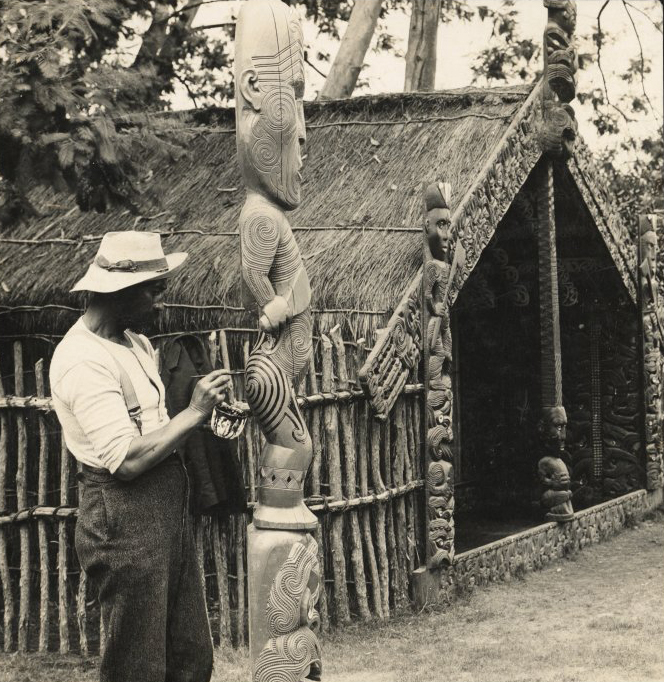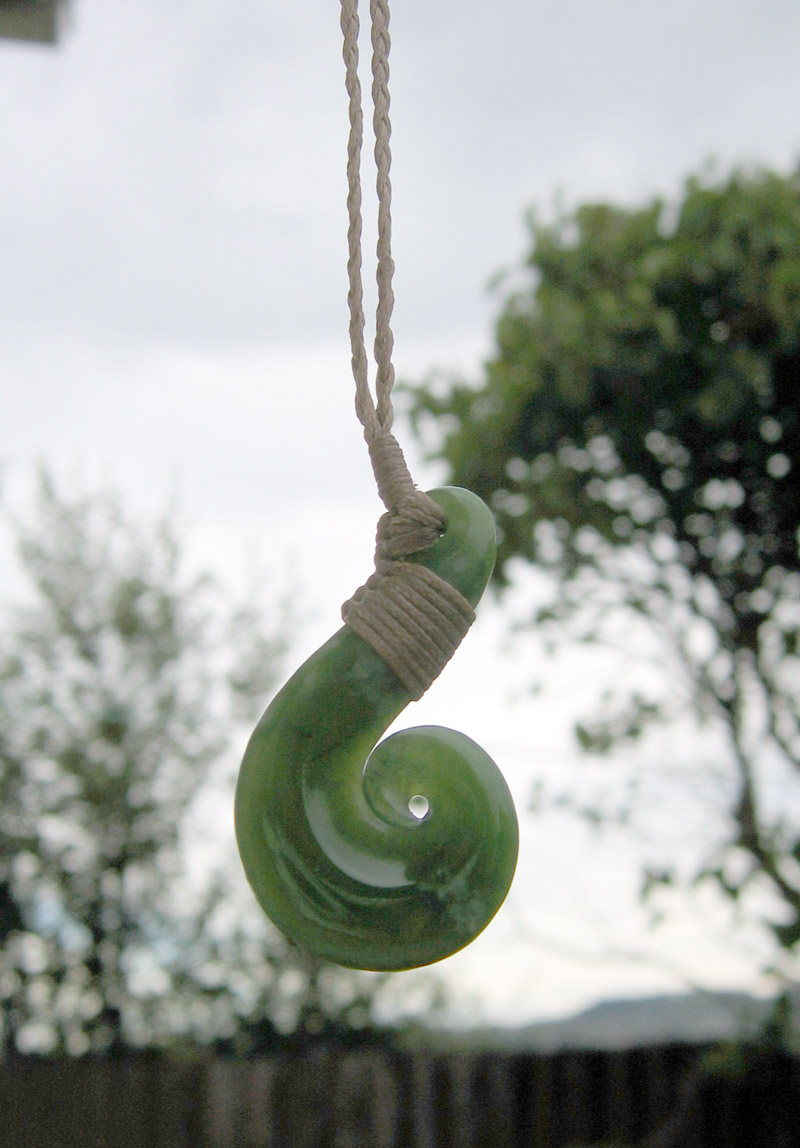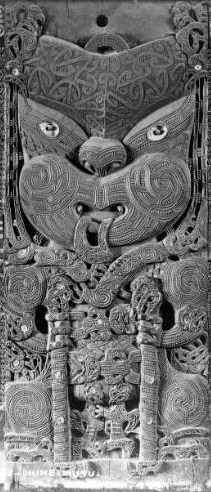|
Hei-tiki
The hei-tiki (, ) is an ornamental pendant of the Māori of New Zealand. Hei-tiki are usually made of pounamu ( greenstone), and are considered a taonga (treasure) by Māori. They are commonly called '' tiki'' by New Zealanders, a term that originally refers to the first mortal. (The word ''hei'' in Māori can mean "to wear around the neck".) Retailers sell tourist versions of hei-tiki throughout New Zealand—these can be made from jade, other types of stone, plastic, or other materials. Origins and materials One theory of the origin of the hei-tiki suggests a connection with Tiki, the first man in Māori legend. According to Horatio Gordon Robley, there are two main ideas behind the symbolism of hei-tiki: they are either memorials to ancestors, or represent the goddess of childbirth, Hineteiwaiwa. The rationale behind the first theory is that they were often buried when their kaitiaki (guardian) died and retrieved later to be placed somewhere special and brought ... [...More Info...] [...Related Items...] OR: [Wikipedia] [Google] [Baidu] |
Jewellery
Jewellery (or jewelry in American English) consists of decorative items worn for personal adornment such as brooches, ring (jewellery), rings, necklaces, earrings, pendants, bracelets, and cufflinks. Jewellery may be attached to the body or the clothes. From a western perspective, the term is restricted to durable Ornament (art), ornaments, excluding flowers for example. For many centuries metal such as gold often combined with gemstones, has been the normal material for jewellery, but other materials such as glass, shells and other plant materials may be used. Jewellery is one of the oldest types of archaeological artefact – with 100,000-year-old beads made from ''Nassarius'' shells thought to be the oldest known jewellery. The basic forms of jewellery vary between cultures but are often extremely long-lived; in European cultures the most common forms of jewellery listed above have persisted since ancient times, while other forms such as adornments for the nose or ankle, impo ... [...More Info...] [...Related Items...] OR: [Wikipedia] [Google] [Baidu] |
Tiki
In Māori mythology, Tiki is the first man created by either Tūmatauenga or Tāne. He found the first woman, Marikoriko, in a pond; she seduced him and he became the father of Hine-kau-ataata. By extension, a tiki is a large or small wooden, pounamu or other stone carving in humanoid form, although this is a somewhat archaic usage in the Māori language, where a tiki is usually a hei-tiki, a pendant worn around the neck. Hei-tiki are often considered taonga, especially if they are older and have been passed down throughout multiple generations. Carvings similar to tiki and coming to represent deified ancestors are found in most Polynesian cultures. They often serve to mark the boundaries of sacred or significant sites. The word has cognates in other Polynesian languages, such as ''tii'' in Tahitian and ''kii'' in Hawaiian. In the Western world, Tiki culture, a movement inspired by various Pacific cultures, has become popular in the 20th and 21st centuries. Religion ... [...More Info...] [...Related Items...] OR: [Wikipedia] [Google] [Baidu] |
Pounamu
Pounamu is a term for several types of hard and durable stone found in the South Island of New Zealand. They are highly valued in New Zealand, and carvings made from pounamu play an important role in Māori culture. Name The Māori word is derived from ''namu'', an archaic word that describes blue-green (or 'grue') cognate with Tahitian ''ninamu''. , also used in New Zealand English, in itself refers to two main types of green stone valued for carving: nephrite jade, classified by Māori as , , , and other names depending on colour; and translucent bowenite, a type of serpentine, known as . The collective term pounamu is preferred, as the other names in common use are misleading, such as New Zealand jade (not all pounamu is jade) and greenstone (a generic term used for unrelated stone from many countries). Pounamu is only found in New Zealand, whereas much of the carved "greenstone" sold in souvenir shops is jade sourced overseas. The Māori classification of pouna ... [...More Info...] [...Related Items...] OR: [Wikipedia] [Google] [Baidu] |
Hei Matau
A ''hei matau'' is a bone or greenstone carving in the shape of a highly stylised fish hook. They represent good luck and safe travel across water. Meaning The fish-hook shape of the ''hei matau'' means to know, which holds that the North Island of New Zealand was once a huge fish that was caught by the great mariner Māui using only a woven line and a hook made from the jawbone of his grandmother. Legend holds that the shape of Hawkes Bay is that of the hei matau, which caught in the fish's side on the beach. The Māori name for the North island, ''Te Ika a Māui'' ("The fish of Māui") reflects this legend. For the Māori, the ''hei matau'' is taonga (a cultural treasure). It represents not only their land, but also prosperity, fertility, and safe passage over water. They also denote the importance of fishing to Māori, and their relationship to Tangaroa god of the sea. Materials and methods Traditionally, ''matau'', or fishhooks, were carved from bone, ivory, shell, wo ... [...More Info...] [...Related Items...] OR: [Wikipedia] [Google] [Baidu] |
Pounamu
Pounamu is a term for several types of hard and durable stone found in the South Island of New Zealand. They are highly valued in New Zealand, and carvings made from pounamu play an important role in Māori culture. Name The Māori word is derived from ''namu'', an archaic word that describes blue-green (or 'grue') cognate with Tahitian ''ninamu''. , also used in New Zealand English, in itself refers to two main types of green stone valued for carving: nephrite jade, classified by Māori as , , , and other names depending on colour; and translucent bowenite, a type of serpentine, known as . The collective term pounamu is preferred, as the other names in common use are misleading, such as New Zealand jade (not all pounamu is jade) and greenstone (a generic term used for unrelated stone from many countries). Pounamu is only found in New Zealand, whereas much of the carved "greenstone" sold in souvenir shops is jade sourced overseas. The Māori classification of pouna ... [...More Info...] [...Related Items...] OR: [Wikipedia] [Google] [Baidu] |
British Museum
The British Museum is a Museum, public museum dedicated to human history, art and culture located in the Bloomsbury area of London. Its permanent collection of eight million works is the largest in the world. It documents the story of human culture from its beginnings to the present.Among the national museums in London, sculpture and decorative art, decorative and applied art are in the Victoria and Albert Museum; the British Museum houses earlier art, non-Western art, prints and drawings. The National Gallery holds the national collection of Western European art to about 1900, while art of the 20th century on is at Tate Modern. Tate Britain holds British Art from 1500 onwards. Books, manuscripts and many works on paper are in the British Library. There are significant overlaps between the coverage of the various collections. Established in 1753, the British Museum was the first public national museum. In 2023, the museum received 5,820,860 visitors, 42% more than the previous y ... [...More Info...] [...Related Items...] OR: [Wikipedia] [Google] [Baidu] |
Bowenite
Bowenite is a hard, compact variety of the serpentinite species antigorite (Mg3(OH)O4Si2O5). Classed as a semi-precious gemstone, it has been used for tools, weapons and jewellery by the Māori in New Zealand, and for jewellery by Fabergé. Deposits are found in several places around the world including Afghanistan, China, New Zealand, South Africa and the United States. It typically ranges in colour from dark green to light olive green, and in shades approaching yellow. Bowenite was named by James D. Dana in 1850 after George T. Bowen, who analyzed it in 1822. Together with nephrite jade the Māori class bowenite as pounamu, which is also known as ''greenstone'', and is of particular significance to the Ngāi Tahu iwi on whose traditional lands on the South Island of New Zealand most deposits are found. Historically it was used for tools, weapons and ornaments, although modern use is limited to jewellery, such as Tiki. The South Island deposits are legally protected, and tak ... [...More Info...] [...Related Items...] OR: [Wikipedia] [Google] [Baidu] |
Hinepare
Rangitukia is a small settlement 10 kilometres south of East Cape in the northeast of New Zealand's North Island. It is near the mouth of the Waiapu River. The settlement is an important place in Ngāti Porou and the founding place for Christian missions in the Gisborne District. The Rangitukia cemetery includes the burial ground of Canon Hone Kaa and former Māori All Black George Nēpia. Labour Party MP Cushla Tangaere-Manuel is from Rangitukia. Marae Rangitukia has two marae, belonging to the Ngāti Porou hapū of Ngāi Tāne, Ngāti Hokopū, Ngāti Nua, Te Whānau a Hunaara, Te Whānau a Rerewa and Te Whānau a Takimoana: Hinepare Marae and Te Tairawhiti meeting house, and Ōhinewaiapu Marae and meeting house. In October 2020, the government committed $1,686,254 from the Provincial Growth Fund Shane Geoffrey Jones (born 3 September 1959) is a New Zealand politician and a member of the New Zealand House of Representatives for the New Zealand First party. ... [...More Info...] [...Related Items...] OR: [Wikipedia] [Google] [Baidu] |
Kaitiaki
Kaitiakitanga is a New Zealand Māori term used for the concept of guardianship of the sky, the sea, and the land. A kaitiaki is a guardian, and the process and practices of protecting and looking after the environment are referred to as kaitiakitanga. The concept and terminology have been increasingly brought into public policy on trusteeship or guardianship—in particular with the environmental and resource controls under the Resource Management Act. Kaitiakitanga The long-established Māori system of environmental management is holistic. It is a system that ensures peace within the environment, providing a process for preventing intrusions that cause permanent imbalances and guarding against environmental damage. Kaitiakitanga is a concept that has "roots deeply embedded in the complex code of tikanga”.Marsden, M., & Henare, T. A. (1992). Kaitiakitanga: A definitive introduction to the holistic world view of the Maori: Unpublished manuscript. Kaitiakitanga i ... [...More Info...] [...Related Items...] OR: [Wikipedia] [Google] [Baidu] |
Collectives
A collective is a group of entities that share or are motivated by at least one common issue or interest or work together to achieve a common objective. Collectives can differ from cooperatives in that they are not necessarily focused upon an economic benefit or saving, though they can be. The term "collective" is sometimes used to describe a species as a whole—for example, the human collective. For political purposes, a collective is defined by decentralized, or "majority-rules" decision-making styles. Types of groups Collectives are sometimes characterised by attempts to share and exercise political and social power and to make decisions on a consensus-driven and egalitarian basis. A commune or intentional community, which may also be known as a "collective household", is a group of people who live together in some kind of dwelling or residence, or in some other arrangement (e.g., sharing land). Collective households may be organized for a specific purpose (e.g., relati ... [...More Info...] [...Related Items...] OR: [Wikipedia] [Google] [Baidu] |
Culture Of New Zealand
The culture of New Zealand is a synthesis of Indigenous peoples, indigenous Māori culture, Māori, colonial British culture, British, and other cultural influences. The country's earliest inhabitants brought with them customs and language from Polynesia, and during the centuries of isolation, developed their own Māori and Moriori cultures. History of New Zealand#Colonial period, British colonists in the 19th century brought Western culture and had a dramatic effect on the indigenous inhabitants, spreading Western religious traditions and the English language. Over time, a distinct Pākehā or New Zealand European culture emerged. More recent immigration from the Pacific, East Asia, and South Asia has added to the cultural diversity in New Zealand. The biggest cultural influence in New Zealand remains Western, with a strong focus on democracy and egalitarianism. Māori culture continues to be an essential part of the national identity, with ongoing efforts to recognise and h ... [...More Info...] [...Related Items...] OR: [Wikipedia] [Google] [Baidu] |
MAP Expo Maori Hei Tiki 15 01 2012 1
A map is a symbolic depiction of interrelationships, commonly spatial, between things within a space. A map may be annotated with text and graphics. Like any graphic, a map may be fixed to paper or other durable media, or may be displayed on a transitory medium such as a computer screen. Some maps change interactively. Although maps are commonly used to depict geographic elements, they may represent any space, real or fictional. The subject being mapped may be two-dimensional such as Earth's surface, three-dimensional such as Earth's interior, or from an abstract space of any dimension. Maps of geographic territory have a very long tradition and have existed from ancient times. The word "map" comes from the , wherein ''mappa'' meant 'napkin' or 'cloth' and ''mundi'' 'of the world'. Thus, "map" became a shortened term referring to a flat representation of Earth's surface. History Maps have been one of the most important human inventions for millennia, allowing humans t ... [...More Info...] [...Related Items...] OR: [Wikipedia] [Google] [Baidu] |







